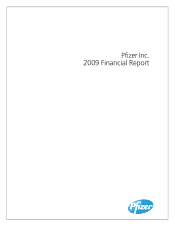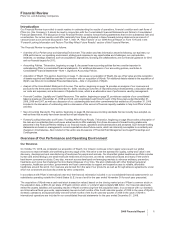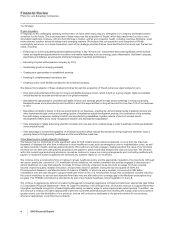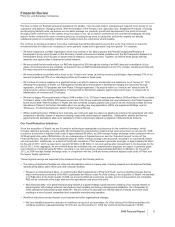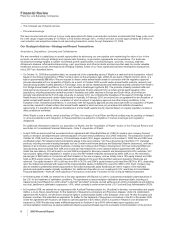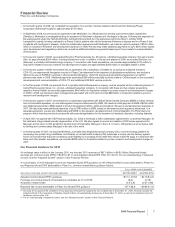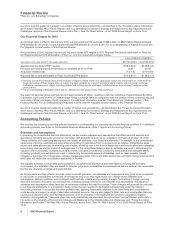Pfizer 2009 Annual Report Download - page 8
Download and view the complete annual report
Please find page 8 of the 2009 Pfizer annual report below. You can navigate through the pages in the report by either clicking on the pages listed below, or by using the keyword search tool below to find specific information within the annual report.
Financial Review
Pfizer Inc. and Subsidiary Companies
•The increased use of shared services.
•Procurement savings.
We have incurred and will continue to incur costs associated with these cost-reduction activities and estimate that these costs could
be in the range of approximately $11.5 billion to $13.5 billion through 2012, of which we have incurred approximately $5.5 billion in
cost reduction and acquisition-related costs (excluding transaction costs) through December 31, 2009.
Our Strategic Initiatives—Strategy and Recent Transactions
Acquisitions, Dispositions, Licensing and Collaborations
We are committed to capitalizing on growth opportunities by advancing our own pipeline and maximizing the value of our in-line
products, as well as through strategic and opportunistic licensing, co-promotion agreements and acquisitions. Our business-
development strategy targets a number of potential growth opportunities, including biologics, vaccines, oncology, diabetes,
Alzheimer’s disease, inflammation/immunology, pain, psychoses, and other products and services that seek to provide valuable
healthcare solutions across developed and emerging markets. Some of our most significant business-development transactions
since 2007 are described below.
•On October 15, 2009 (the acquisition date), we acquired all of the outstanding equity of Wyeth in a cash-and-stock transaction, valued,
based on the closing market price of Pfizer common stock on the acquisition date, at $50.40 per share of Wyeth common stock, or a
total of approximately $68 billion. We are required to divest certain animal health assets in connection with the regulatory approval
process associated with our acquisition of Wyeth. As a result, in October 2009, we sold certain animal health products, research and
manufacturing facilities located primarily in Fort Dodge, Iowa, as well as related assets and intellectual property, primarily from Wyeth’s
Fort Dodge Animal Health portfolio in the U.S. and Canada to Boehringer Ingelheim (BI). The products primarily included cattle and
small animal vaccines and some animal health pharmaceuticals. BI also acquired from us certain animal health assets in other
jurisdictions, including companion animal vaccines in Australia, and cattle vaccines in Europe and South Africa, all of which are
primarily manufactured at the Fort Dodge, Iowa site. In January 2010, we completed the divestiture of the legacy Fort Dodge Animal
Health livestock business and certain related assets in Australia. In February 2010, we entered into an agreement for the divestiture of
certain animal health assets in China, completion of which is subject to regulatory approval and other closing conditions. In the
European Union, Switzerland and Mexico, in connection with the regulatory approval process associated with our acquisition of Wyeth,
we are also required to divest certain other animal health assets for which we have not yet entered into definitive transaction
agreements. It is possible that additional divestitures of animal health assets may be required based on ongoing regulatory reviews in
other jurisdictions worldwide.
While Wyeth is now a wholly owned subsidiary of Pfizer, the merger of local Pfizer and Wyeth entities may be pending or delayed
in various jurisdictions and integration in these jurisdictions is subject to completion of various local legal and regulatory
obligations.
For additional information related to our acquisition of Wyeth, see the “Acquisition of Wyeth” section of this Financial Review and
see Notes to Consolidated Financial Statements—Note 2. Acquisition of Wyeth.
•In April 2009, we announced that we entered into an agreement with GlaxoSmithKline plc (GSK) to create a new company focused
solely on research, development and commercialization of human immunodeficiency virus (HIV) medicines. The transaction closed on
October 30, 2009, and the new company, ViiV Healthcare Limited (ViiV), began operations on November 2, 2009. We and GSK have
contributed certain HIV-related product and pipeline assets to the new company. ViiV has a broad product portfolio of 11 marketed
products, including innovative leading therapies such as Combivir and Kivexa products and Selzentry/Celsentri (maraviroc), and has a
pipeline of six innovative and targeted medicines, including four compounds in Phase 2 development. ViiV has contracted R&D and
manufacturing services directly from GSK and us and also has entered into a new research alliance agreement with GSK and us.
Under this new alliance, ViiV will invest in our and GSK’s programs for discovery research and development into HIV medicines. ViiV
has exclusive rights of first negotiation in relation to any new HIV-related medicines developed by either GSK or us. We recorded a
pre-tax gain of $482 million in connection with the formation of the new company; and we initially hold a 15% equity interest and GSK
holds an 85% equity interest. The equity interests will be adjusted in the event that specified sales and regulatory milestones are
achieved. Our equity interest in ViiV could vary from 9% to 30.5%, and GSK’s equity interest could vary from 69.5% to 91%, depending
upon the milestones achieved with respect to the original pipeline assets contributed by us and by GSK to ViiV. Each company may
also be entitled to preferential dividend payments to the extent that specific sales thresholds are met in respect of the marketed
products and pipeline assets originally contributed. For additional information on our investment in ViiV, see Notes to Consolidated
Financial Statements––Note 3A. Other Significant Transactions and Events: Formation of ViiV, an Equity-Method Investment.
•In the first quarter of 2009, we entered into a five-year agreement with Bausch & Lomb to co-promote prescription pharmaceuticals in
the U.S. for the treatment of ophthalmic conditions. The agreement covers prescription ophthalmic pharmaceuticals, including our
Xalatan product and Bausch & Lomb’s Alrex®, Lotemax®and Zylet®products, as well as Bausch & Lomb’s investigational anti-infective
eye drop, besifloxacin ophthalmic suspension, 0.6%, which currently is under review by the U.S. Food and Drug Administration (FDA).
•In December 2008, we entered into an agreement with Auxilium Pharmaceuticals, Inc. (Auxilium) to develop, commercialize and supply
Xiaflex, a novel, first-in-class biologic, for the treatment of Dupuytren’s contracture and Peyronie’s disease. Under the collaboration
agreement with Auxilium, we will receive exclusive rights to commercialize Xiaflex in the European Union and 19 other European and
Eurasian countries. We submitted an application for Xiaflex for the treatment of Dupuytren’s contracture in the EU in December 2009.
Under the agreement with Auxilium, we made an upfront payment of $75 million, which is included in Research and development
expenses in 2008. We also may make additional payments to Auxilium of up to $410 million based upon regulatory and
commercialization milestones, as well as additional milestone payments based upon the successful commercialization of the product.
6 2009 Financial Report

